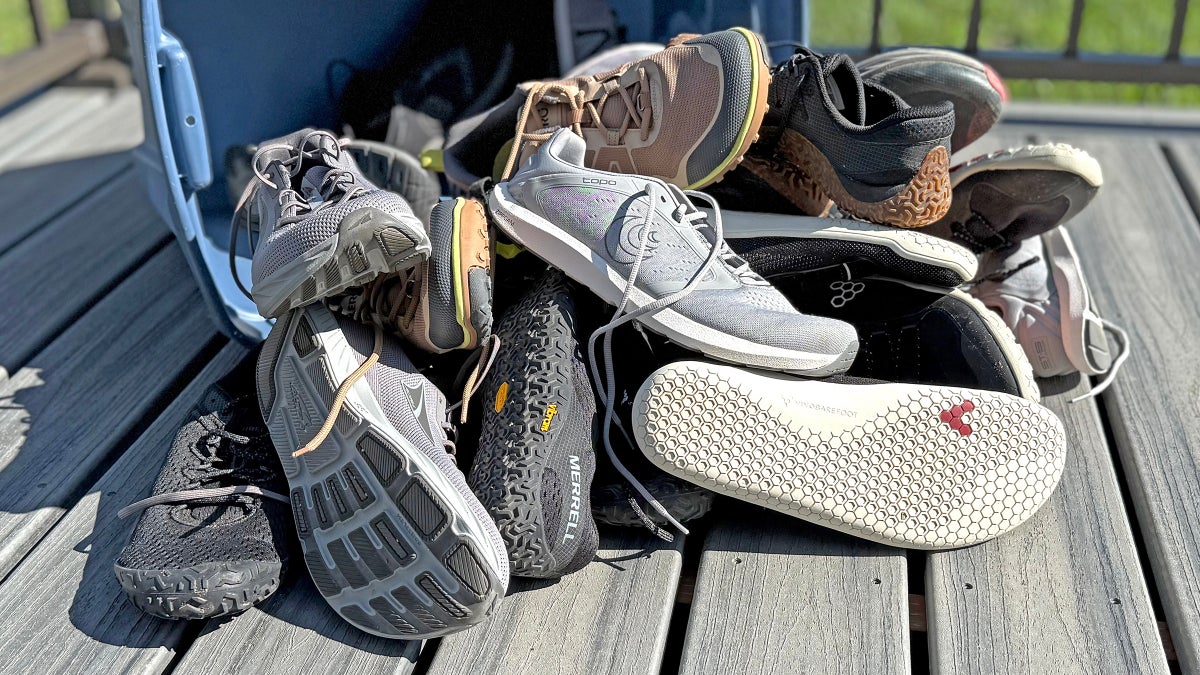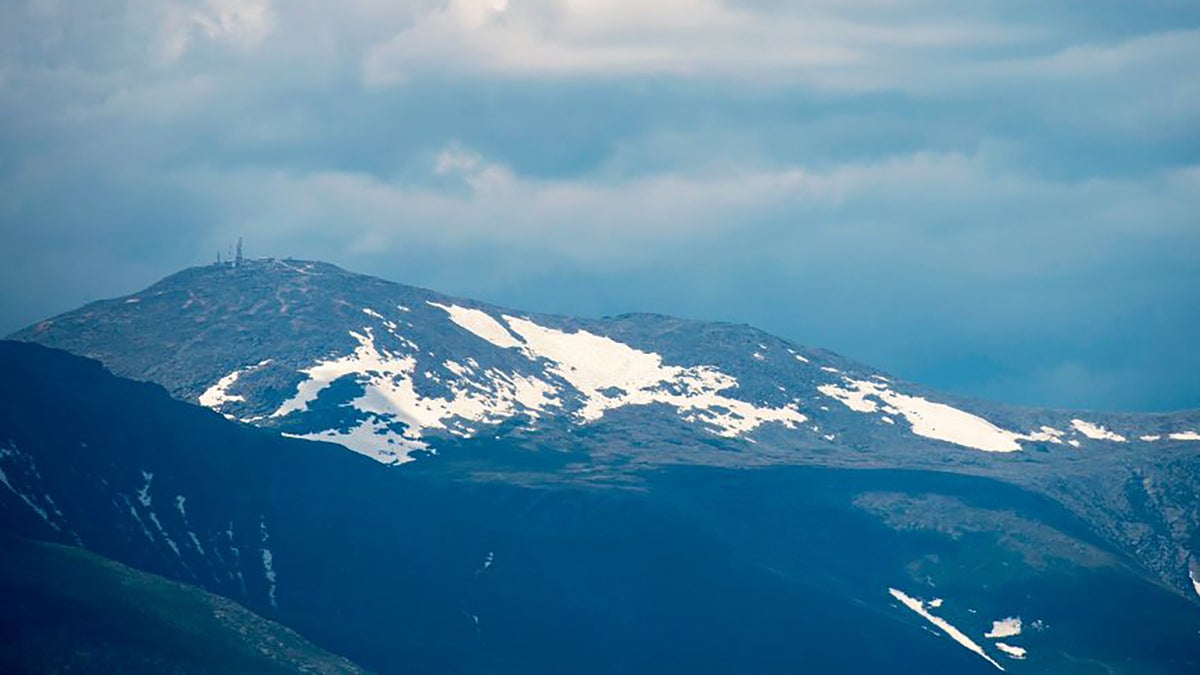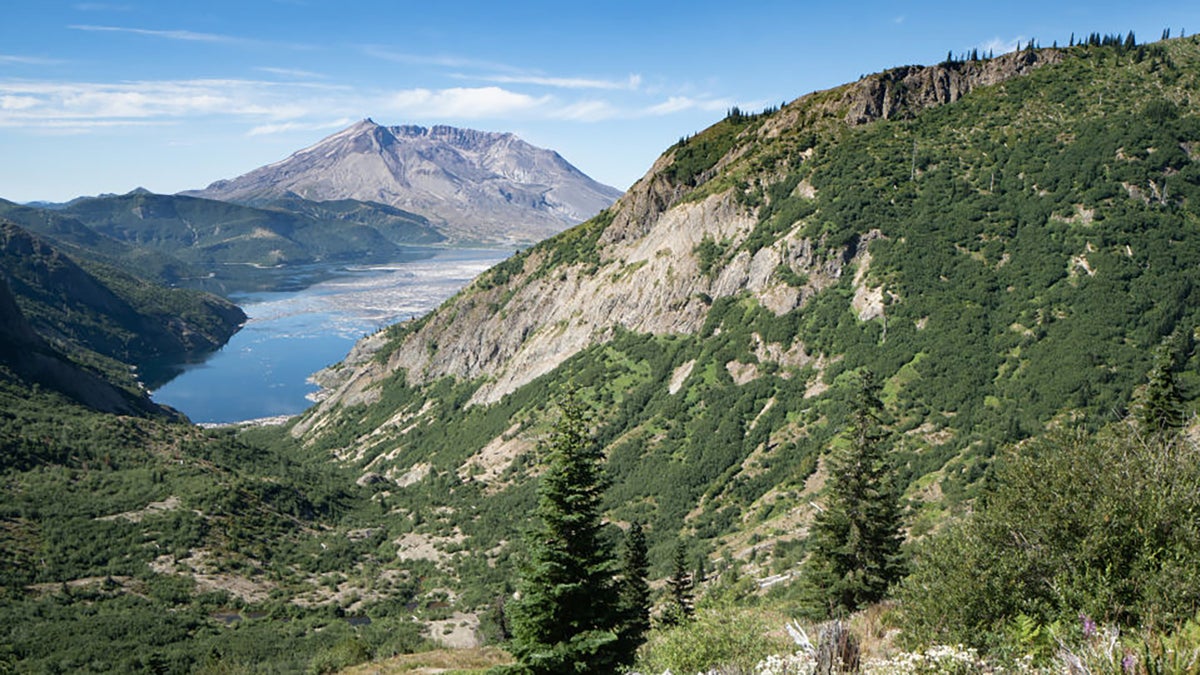
The running world’s brief, passionate affair with the minimalist movement may have burnt out more than a decade ago, but minimalist running shoes are alive and well—and experts agree there are good reasons you should own a pair.
At a Glance
- Why Wear Minimalist Shoes?
- What Is a Minimalist Shoe?
- Maximizing Your Minimalist Experience
- Meet Our Lead Tester
Minimalist shoe reviews, sorted from thinnest sole to thickest:
- Vivobarefoot Primus Lite Knit ($175)
- Merrell Vapor Glove 6 and Glove 6 BOA ($100-120)
- Vivobarefoot Primus Trail III All Weather FG ($175)
- Vibram Five Fingers V-Run ($160)
- Xero Shoes HFS II ($120)
- Merrell Trail Glove 7 ($120)
- Topo ST-5 ($120)
- Xero Shoes Scrambler Low EV ($150)
- Altra Superior 7 ($120)
- Altra Escalante 4 ($130)
Why Wear Minimalist Running Shoes?
Many sports med professionals continue to tout the benefits of minimalist footwear today, long after the fad faded. “Even in a world dominated by maximalist footwear, I often recommend minimalist shoes—especially for casual wear, walking, and as part of a running shoe rotation,” says sports podiatrist Rob Conenello. Conenello points out how the shoes encourage foot muscle engagement and better proprioception—the foot’s ability to sense and interact with the ground—and, he says, “A stronger foot leads to a more efficient and injury-resistant athlete.”
Fellow sports podiatrist Paul Langer agrees, “The health benefits are supported by more and more research every year. I recommend minimalist shoes for almost all my patients because they have potential benefits that include improving foot strength and mobility, decreasing the risk of falling, and reducing foot pain.”
Jay Dicharry, physical therapist and biomechanics researcher, says every runner should have a minimalist model as one of their running shoes. “Putting less between you and the ground means the shoe’s cushion and geometry can’t do the work for you,” Dicharry explains. “Spending time walking, and yes, some running, in minimal shoes will load your foot and lower leg a lot more. This increased load cues your body to build stronger bones, muscles, tendons, and durability in your feet. And a direct connection between your feet and the ground does wonders for your nervous system, your sense of stability, and can help filter out some imbalances in your stride.”
What Is a Minimalist Running Shoe?
If you’re ready to follow this advice, you first need to know what makes a shoe minimalist. Minimalist running shoes are born from the assumption that the best, most natural running is done barefoot. Your feet should be free to be feet: complex constructions of arches, cables, and levers that react and adapt instantly to cushion, stabilize and propel. Given that most people today didn’t grow up going bare in all conditions, and thus didn’t develop the calloused soles necessary to tread safely and comfortably on all but the softest terrains, most minimalists concede that some sort of shoes are a necessary evil. But, to maintain natural proprioception and muscle activation, and encourage efficient posture and gait patterns, they believe shoes should stay as close to bare as possible.
What makes a shoe minimalist is a matter of debate, but in 2015, 42 experts from 11 countries agreed on a formal definition: “Footwear providing minimal interference with the natural movement of the foot due to its high flexibility, low heel to toe drop, weight and stack height, and the absence of motion control and stability devices.” That definition provided parameters to determine how minimal any particular pair is, but left open to interpretation the exact line where a shoe becomes too high, too stiff, or too controlling to be considered minimalist. If you choose to go more minimal, it is up to you to decide which characteristics are most important and how low you want to go.
Maximizing Your Minimalist Experience
Put on a pair of minimalist shoes and you instantly feel light, nimble, and alive. Head out the door and you dance along, feeling a new, intimate, interactive connection with the earth beneath your feet—until you tire and start clomping along with no cushioning underfoot and return home to find your calves and achilles screaming. Most runners need to transition to minimal footwear very gradually, building up miles in them as slowly as they first added running miles when a beginner, or using them only occasionally as training devices.
“By removing the artificial cushioning and support, the feet are forced to do more work,” Langer explains. “This increased workload, if done gradually, will increase the foot’s capacity to support the body by strengthening muscles and ligaments and other connective tissue and allowing the joints to move in a broader range of motion. If not done gradually, people often get injured with metatarsal stress fractures, plantar fasciitis calf strains or Achilles tendinitis.”
Whether or not you adopt minimal footwear all the time, using them sparingly is worthwhile to improve your posture and stride, as well as foot strength—particularly if combined with exercises to enhance hip flexibility and strengthen your posterior chain and feet. And nearly everybody can use minimal shoes for walking and daily wear, which experts agree can be as valuable for improving your biomechanics as running in them.
Meet Our Lead Tester
Jonathan Beverly, Senior Running Editor, Gear
I fell in love with running my freshman year in high school in 1977, and quickly became fascinated with finding the perfect pair of running shoes. That quest got a boost when I became editor of Running Times in 2000 and started receiving every new model as they were released. I embraced the minimalist movement in the early 2010’s, running thousands of miles—including road and trail races—in barely-there shoes which reconnected me with my body and the earth, rejuvenating my running. But after suffering a metatarsal stress fracture and seeing others get injured in minimalist footwear, I dug into the contradictory studies on shoes and running form and talked to dozens of experts—from scientists to medical professionals to coaches—trying to determine common ground. That research turned into a book, Your Best Stride, which explores how to counteract the forces of a modern sedentary lifestyle and restore natural posture and movement so you can run more effectively (in any footwear).
Today, I wear every type of running shoe as a tester, but retain a preference for more minimal models, which I wear exclusively when not running. During this testing, however, I found that my adaptation to running in ultra-thin shoes had waned and my experience in them seemed typical for runners who have some experience with light, low models but are mostly accustomed to today’s high, soft shoes.
For this review, I ran in each model several times over three months, on different terrains and at a variety of paces, from jogs to sprint intervals. I also rotated them as my exclusive walking and casual shoes throughout the test period, including hikes up to 10 miles. Here are my picks for the best minimalist shoes for running today, ranging from nearly-bare to lightly-cushioned models.
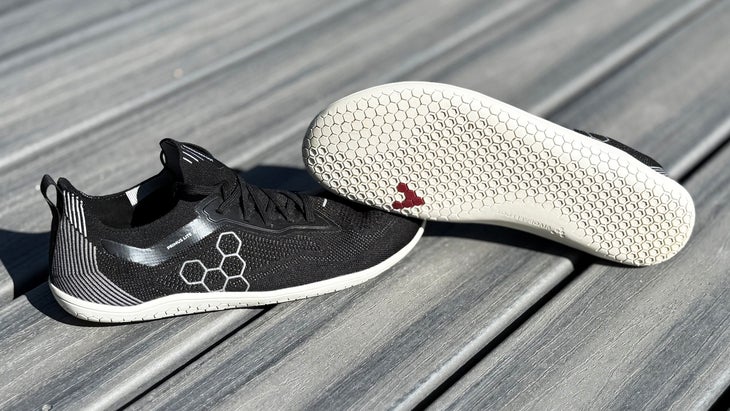
Vivobarefoot Primus Lite Knit
$175 at REI $175 at Vivobarefoot
Weight: 8.7 oz (men’s)/ 6.5 oz (women’s)
Sole Thickness: 6 mm (includes removable 2 mm insole)
From the first step in the Vivobarefoot Primus Lite Knit I felt a sense of freedom and connection, like being barefoot but with a tough, protective skin removing fear of sharp things underfoot. The sole is the thinnest of the shoes I tested if you remove the insole (tied with the Merrell Vapor Glove 6 with the insole), and flexes without resistance in all directions. The thin, knit upper, made with recycled plastics, is equally flexible, and, although the shoe’s width is voluminous, holds the rearfoot securely thanks to a stretchy, booty-like upper with overlay straps hugging the instep, plus a softly molded heel cup that snugs with light padding.
I wore these mostly casually, the ground feel always surprising me for the first few steps and quickly cueing my feet to engage and posture to straighten up. Runs in them were short, quick bursts, relishing the feeling of power transferring through my feet but being careful not to tire and start clunking. After, my feet always felt like I had done a “foot day” strength workout, that pleasant soreness that says they are alive.
One note: the size was so big the fabric bunched up between the eyelets. While I didn’t slide around in the shoe, a half size smaller than my usual running shoe would have fit better without interfering with toe space.

Merrell Vapor Glove 6 and Glove 6 BOA
$100-120 at Merrell (Men’s) $100-120 at Merrell (Women’s)
Weight: 5.6 oz (men’s) / 4.6 oz (women’s) — BOA 6.7 oz (men’s) / 5.5 oz (women’s)
Sole Thickness: 6 mm
As the lightest, airiest, and tied-for-thinnest-soled shoe in the test, I could almost forget I had the Merrell Vapor Glove 6 on, except when I didn’t have to tread gingerly over iffy surfaces and gripped the trail better than when barefoot. I loved the breathable, slipper-like upper that has surprisingly plush padding in the ankle collar and the gusseted tongue, and the thin Vibram outsole, with 2.5-millimeter-deep, squiggly-line lugs. And I loved how the two worked together to move invisibly with my foot while providing robust protection, without trying to control or dulling my proprioception.
The Vapor Glove 6 is too minimal for me to do much running in these days (except for short hill sprints during walks), but when I wore them casually I could feel my feet activating and strengthening, and my balance improving. The laced version was stylish enough to wear extensively at work and around town, and I reached often for the BOA version—which makes cinching and adjusting tension as easy as turning a dial—while gardening and on long, dirt-road walks with my dogs.

Vivobarefoot Primus Trail III All Weather FG
$175 at REI $131 at Vivobarefoot
Weight: 11.1 oz (men’s) / 7.8 oz (women’s)
Sole Thickness: 7.5 mm (includes removable 2 mm insole)
Every time I pulled on these all-weather, trail-ready Vivobarefoots and snugged the fit with the simple and effective pull-cord lace, my feet felt alive and ready to dance. The 7.5-millimeter-thick sole—including 2.5–millimeter-deep, “firm-ground” lugs—added just enough underfoot to make me feel confident running in them—but in a specific, limited context. Having noted that my cadence has been slowing while wearing cushioned shoes, I decided these shoes, with barefoot-like ground feel but solid underfoot protection and grip, were the perfect tool in which to restore my springs. My weekly routine has become this: I sprint up a dirt road with quick, powerful strides, until I start to tire and my turn-over slows, then I’ll walk until I’m ready to do another high-cadence 200 to 300 meters, repeating until I’ve gone 1.5 to 2 miles. My foot and lower leg muscles are inevitably sore the next day, but I can already feel a renewed quickness and bounciness to my stride.
The firm sole, which wraps up around the edges in wavy sidewalls, flexes with ease, enabling full range of motion and terrain-adaptable landings and push-offs. Up top, the rugged, water-resistant fabric (95% RPET, 5% Spandex) flexes in the right places and secures the midfoot with a sturdy TPU saddle overlay, while the wide forefoot doesn’t interfere with splay, even wearing CorrectToes. The weight of the sole and protective upper make this shoe as or more suitable for hiking as for running—I comfortably did several 1–2 hour hikes in them and they felt durable enough to hold up to whatever terrain I took them on.
Note: the fit runs large, I had to get a pair a half size smaller than my usual running shoe size.
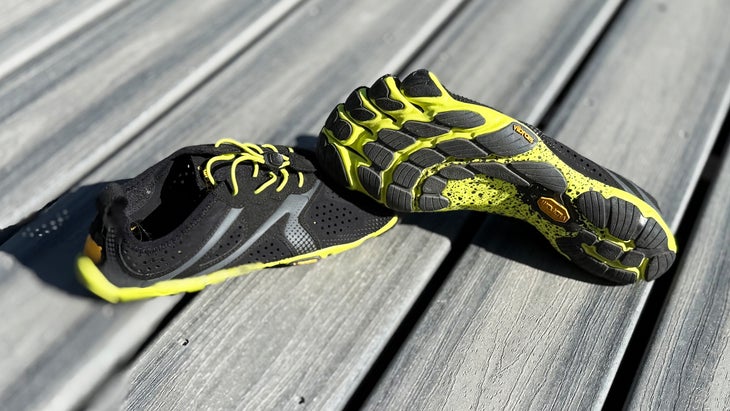
Vibram Five Fingers V-Run
Weight: 4.8 oz (men’s) / 3.9 oz (women’s)
Sole Thickness: 8.5 mm (includes non-removable insole)
Running in Five Fingers is a familiar sensation for those who lived through and embraced the minimalist movement: a feeling of running barefoot as a child, free, alive and in touch with the earth. The design delivers unsurpassed toe splay, enforced by the separate toe pockets, and a close-to-the-ground, near-barefoot ride. I put in many miles in Five Fingers in the early 2010s on terrain ranging from asphalt streets to gravel backroads to jungle mud, and always felt like my body was waking up and paying attention. I also got injured going too long, too hard, too soon. This time I used them for shorter runs a couple of times per week, and loved the reconnection with the earth, always ending up doing some fast, nimble pickups or hill sprints.
The V Run is lighter than the original, while more supportive. The weight reduction comes mostly from the thin, perforated upper, that is more breathable but less soft than the original knit, and the removal of much of the outsole rubber. The pads that remain are attached to a four-millimeter-thick sculpted EVA midsole that adds some support as well as padding. I found the V-Run felt protective and fast, stiffening my foot lever a bit, but it also felt slightly more removed from the ground, somewhat stiffer, and less comfortable than the original.
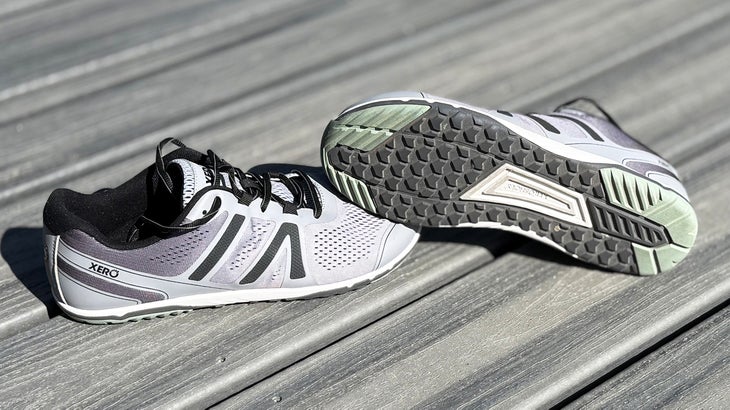
Xero Shoes HFS II
$120 at REI (Men’s) $120 at REI (Women’s)
Weight: 8.3 oz (men’s), 6.7 oz (women’s)
Sole Thickness: 12.5 mm (includes removable 3.5 mm insole)
The Xero HFS II’s sole is thin, unscultped (no hint of arch support), zero-drop, and entirely flexible, but has just enough underfoot padding (12.5 millimeters between foot and ground) to make it far more accessible to the majority of runners than a non-cushioned barefoot shoe. The first time I took them out I intended to mix walking with short run bursts, but found myself padding comfortably along and ended up running continuously for three miles on sidewalks, with a couple of grassy hill sprints thrown in. The next day I could feel the foot and calf muscles that got extra work, but they weren’t sore enough to warrant scaling down my planned run. I wore the HFS II as my only casual shoe for a week, which included walking two miles on city streets daily, and felt more comfortable and energetic than when wearing highly cushioned shoes.
Credit the thin layer of firmly responsive EVA for easing the transition. It contours and protects the bony protrusions underfoot but doesn’t sink and dull my proprioception of the ground, cueing my muscles to react and engage and my stride to get lighter and more balanced. For those wanting more underfoot feel, the 3.5 millimeter insole can be removed, leaving a smoothly finished interior with just fabric covering the midsole. The shape is wide and roomy from heel to toe, but holds the rear- and mid-foot securely with a well-padded collar and strategic straps that loop into the laces and wrap the instep. The chevron outsole lugs are flat-topped and thickly spaced enough to roll smoothly over roads but deep enough to grip on dirt: I ended up running mostly on gravel, which the shoe felt best suited for. My only beef was that the barrel laces felt clumsy when tightening the shoe and came untied easily.

Merrell Trail Glove 7
$120 at REI (Men’s) $120 at REI (Women’s)
Weight: 8.5 oz (men’s) / 6.0 oz (women’s)
Thickness: 14 mm (includes non-removable insole)
The Trail Glove 7 crosses over the line from what I would consider barefoot shoes to minimalist running shoes. While still zero-drop, flexible, and not overly cushioned (11.5 millimeters of Merrell’s proprietary, firm-and-responsive FloatPro foam), they didn’t make my feet work as much as more minimal models, making it easy to put in more trail miles in them right off the bat—but producing less of a training effect. I appreciated the grip from the 2.5-millimeter-deep, 30-percent recycled, Vibram-rubber lugs, and the support where the outsole wraps up in high sidewalls on both sides of the arch and over the heel and toe. The fit lives up to its glove-like name with a flexible mesh upper that wraps securely over the gusseted tongue, and a slightly narrower shape than other minimalist models.
Although agile on the run, I didn’t run in these very often after an initial week of testing over a variety of distances and paces, given that they offer neither the strong foot-strengthening stimulus of barefoot models nor the underfoot cushion of slightly thicker shoes. Their easy-going comfort, however, made them a frequent choice for casual wear and long walks that bordered on hikes, where their middle-of-the-road cushioning and solid stability proved just right.
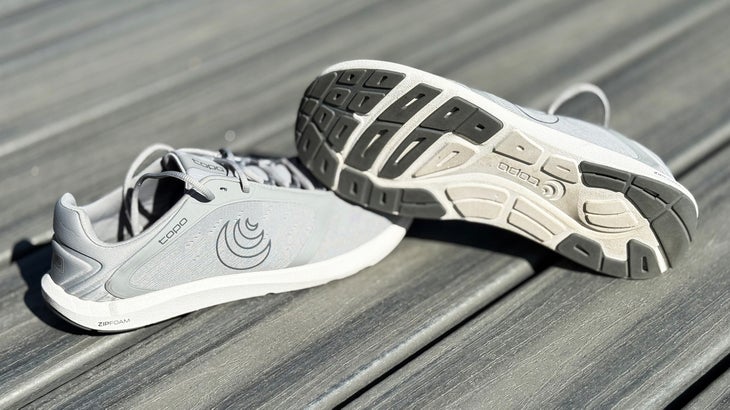
Topo ST-5
$120 at REI $120 at Topo Athletic
Weight: 6.6 oz (men’s) / 5.3 oz (women’s)
Sole Thickness: 14 mm (includes removable insole)
The Topo ST-5 is the shoe I take on a trip to wear all day, every day, and know I will be comfortable and light-footed whether I’m walking for miles on concrete sidewalks, standing for hours at an expo, doing strength and plyometric work, or running short distances. The soft, flexible upper hugs my foot from heel to ball like a second skin, while the toe box is roomy and airy, with plenty of space for splay, even wearing CorrectToes. Underfoot, 14 millimeters (two millimeters less than the ST-4) of firmly bouncy Zipfoam allows me to feel and interact with the ground without getting bruised by it, and flexes easily in all directions, letting my arch and toes move freely.
Clean styling and subdued colors (I have both a black and a grey pair) let me wear the ST-5 anywhere from a run to a restaurant without feeling out of place. I reached for this shoe more often than any other shoe in the test because it disappears (from sight and feel) and lets me move nimbly and naturally without thinking about my feet or ending the day beat up.
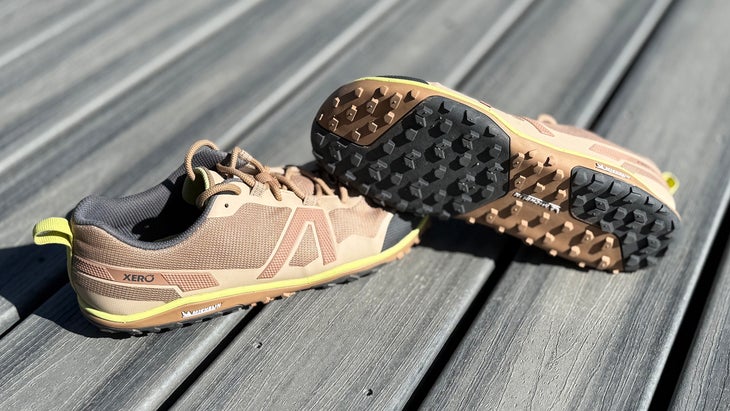
Xero Shoes Scrambler Low EV
$150 at REI (Men’s) $150 at REI (Women’s)
Weight: 9.2 oz (men’s) / 7.4 oz (women’s)
Sole Thickness: 15 mm (includes removable 3.5 mm insole)
The first thing that stands out about the Scrambler Low EV is how rugged it is: from the full-coverage, wide-lugged, Michelin tire rubber sole to the robust, abrasion resistant upper, this shoe it is built to last—Xero is so confident it guarantees the sole for 5,000 miles. Fifteen millimeters of rubber and responsive foam lie between foot and ground, offering ample protection for your foot during those miles. Compared to other Xeros, the Scrambler Low EV sacrifices some softness and flexibility for that protection and durability. It maintains Xero’s effective midfoot straps that loop into the laces and snug the instep, but in terms of fit and flexibility, it feels more like a light hiking shoe than a speedy trail slipper (like the still-available Mesa Trail II that I love for its soft, foot-wrapping fit).
Given its ruggedness, hiking is where I ended up appreciating the Scrambler most, where it gave me confidence that it could stand up to whatever I stepped on or brushed against, and allowed stable and secure footplants on any terrain. For running, I found it felt more agile with the 3.5 millimeter insole removed, which improved the flexibility and ground proprioception while maintaining the shoe’s protection and sure-footed grip.
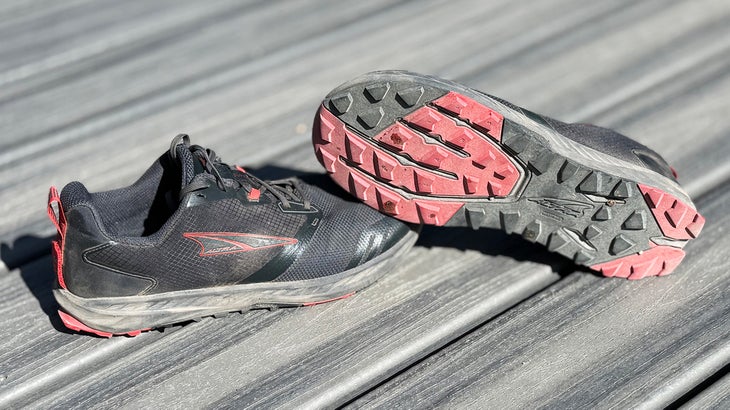
Altra Superior 7
$120 at REI $120 at Running Warehouse
Weight: 9.3 oz (men’s) / 7.7 oz (women’s)
Sole Thickness: 21 mm (includes removable insole)
Full disclosure, I’ve been an unapologetic fan-boy of the Superior since it came out—the flexible, balanced ride makes me feel like a wild animal gliding over the earth, and the thin sole provides enough padding that I can run in them daily as long as I stay tall and land lightly. I took the Superior 7 out in western Nebraska’s sandhills and Utah’s rocky Wasatch Mountains, and found it as nimble as ever, equally capable on both terrains.
Underfoot, the 21 millimeter sole without a rock plate softens landings but still lets me feel the ground enough to dance agilely over uneven and unpredictable terrain, adapting to each varied footplant. It doesn’t, however, morph and swallow rocks like a thicker shoe, thus requires foot and ankle strength to adapt and support on rough trails—I could feel the strain after longer outings, and noted my strength and reactive skills improving over time. On softer terrain, the low, widely spaced lugs dig in and grip but don’t get bogged down.
The redesigned upper is easy to cinch down for a secure fit, while, as expected from Altra, allowing plenty of room for splay. The mesh forefoot is flexible and breathable, while TPU overlays around the toe and saddle enhanced the durability and hold, although seeming a bit plasticky (until dirt build-up took the shine off).

Altra Escalante 4
$130 at REI (Men’s) $130 at REI (Women’s)
Weight: 9.5 oz (men’s)/ 7.5 oz (women’s)
Sole Thickness: 24 mm (includes removable insole)
The Escalante is foot-shaped and zero-drop, but doesn’t count as a true minimalist running shoe to purists as it has 24 millimeters of cushy, bouncy foam reducing the flexibility, ground feel, and foot activation and strengthening. Compared to most of today’s shoes, however, I found the thin sole provided plenty of proprioception, enhanced by Altra’s proprietary AltraEGO foam that firms up quickly on compression with a lively bounce-back. The lightly structured, engineered knit upper coddled my feet without cramping them or controlling their movement.
I found myself running tall and striding quickly in these, and was able to go as long as I wanted without feeling post-run foot and calf soreness. For many runners, the Escalante makes an effective second shoe to run in a few times a week to vary the stress, strengthen the feet, and cue different movement patterns—without getting so beat up they have to reduce mileage.
For other minimalist options, also look into:
And for an even more minimalist feel, consider sandals from:
The post The Best Minimalist Running Shoes appeared first on Outside Online.











